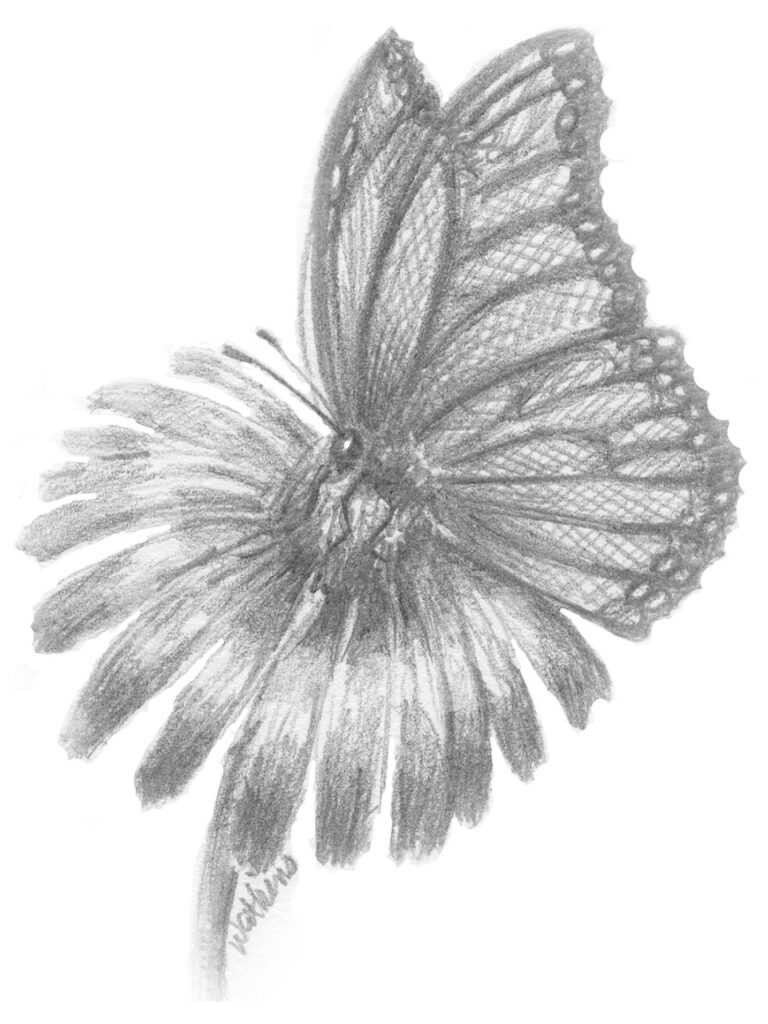August, Joy & Freedom
Through the Garden Gate
By Leslie Watkins
“Just living is not enough,” said the butterfly, “one must have sunshine, freedom and a little flower.” —Hans Christian Andersen
Butterflies bring life into our gardens. Select a few plants that they are attracted to and they will come. Like flying jewels, they flit from flower to flower seeking nectar. Looking at their fragile beauty it is hard to believe that some fly thousands of miles to reach their destination. But they do, guided by the magnetic pull of the earth and the sun. Butterflies symbolize strength, joy, freedom, transformation and spiritual awakening.

The life cycle of the butterfly is egg, larva, pupa, then butterfly. The length of time spent in each of these stages varies widely by species, but most butterflies live for only one to nine months. They are preyed upon by birds, toads, frogs, dragonflies, wasps and spiders. For protection they have developed elaborate designs of camouflage and mimicry, or as in the case of monarchs, they just taste bad. Some have spots that look like eyes. The spicebush swallowtail caterpillar takes it to another level. It has large eye spots complete with highlights and an inflatable “tongue” that shoots out as the caterpillar rears up and bobs like a snake when threatened.
You can attract butterflies by growing in sunny spots nectar-rich flowers with flat tops that can be used as landing pads. Purple, red, orange, yellow and pink flowers are especially attractive. For menu variation you can use a plate or a suet feeder to hold moist, over-ripe fruit to attract some butterflies. Keep this away from the house, as it may attract wasps, too. Butterflies are often seen “puddling” as they seek salts and minerals found in puddles.
Some of the more common butterflies in our gardens include the black swallowtail, cabbage white, eastern tiger swallowtail, meadow fritillary, painted lady and monarch. Many of these insects have a preference for particular plants to lay eggs on to provide food for the caterpillar stage. If you look closely, you may find the gorgeous yellow, black and white striped larvae of the monarchs on the underside of milkweed leaves, chomping away. Growing dill and parsley in your herb garden may attract black swallowtail caterpillars. They have bright green and black stripes with yellow dots and black dashes.
Butterfly imagery has decorated the walls of Egyptian tombs, jewelry and woven textiles throughout the ages. Countless paintings of butterflies decorate china, manuscripts and wallpaper. They’ve been sculpted out of paper, plastic, metal and wood, and embroidered onto clothing, hats and baskets. Butterfly hairstyles are created by elaborate braiding, and butterfly whorls are worn by Hopi young women.
In the last two decades monarch butterfly numbers have dropped 90 percent, and they’re now on the brink of extinction. To help threatened butterfly species, grow milkweed wherever you can. It’s a lovely native plant with a delicious fragrance that grows easily in sunny spots. Milkweed is a favored edible for human consumption, too. The pods are collected when small and unripe. They can be steamed like okra, added to pasta or battered and fried “buffalo” style. The flowers are used to flavor beverages and desserts.
To grow milkweed, collect the pods as they begin to crack open and the seeds are brown. Scatter them in a sunny spot before winter. They require stratification, or a period of cold, to germinate. The mature seeds can also be dried and stored in the refrigerator and planted in flats in early spring. The seed coats require scarification to germinate. To scarify the seeds, place them in a container with coarse sand and shake for half a minute. Sprinkle them into flats, cover lightly and keep moist.
Butterfly Plants
- Asters, Symphyotrichum
- Butterfly bush, Buddleia davidii
- Butterflyweed, Asclepias tuberosa
- Joe-pye weed, Eupatorium
- Milkweed, Asclepia
- Purple coneflower, Echinacea
- Steeplebush, Spiraea tomentosa
- Sweet pepperbush, Clethra alnifolia
- Vebena bonariensis
- Zinnia elegans
